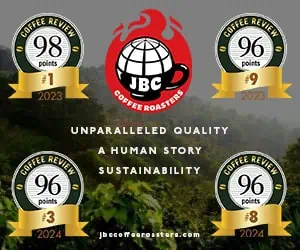The only way to really understand roast is to associate flavor with the color and appearance of the bean rather than with name alone, but for reference I have condensed most of what an aficionado needs to know about the names of roasts in the following roast table.
| Roast color | Bean surface | Agtron Numbers | Common names | Notes |
| Light brown | Dry | 80 – 70 |
Light Cinnamon New England |
Can taste sour and grainy. Typically used only for inexpensive commercial blends. |
| Medium brown | Dry | 70 – 50 |
Medium American Regular City Brown |
The traditional American norm. Flavor is fully developed; acidity is bright; characteristics of green coffee are clear. |
| Medium-dark brown | Dry to tiny droplets or patches of oil | 50 – 40 |
Viennese Full-city Light French Espresso Light espresso Continental After-dinner European |
The normal or regular roast for the West and for many newer specialty roasters. Acidity and the characteristics of the green coffee begin to mute. Bittersweetness emerges. The norm for northern-Italian style espresso. |
| Dark brown | Shiny surface | 40-35 |
French Espresso Italian Turkish Dark |
The normal or regular roast for many roasters in the West and Southwest. Acidity is nearly gone; the characteristics of the green coffee muted. Bittersweet tones dominate. The norm for most American-style espresso. |
| Very dark brown | Very shiny surface | 35-30 |
Italian Dark French Neapolitan Spanish Heavy |
The normal or regular roast for Peet’s Coffee and its imitators. Acidity is gone. In tactful versions of this roast some characteristics of the green coffee survive; in aggressive versions all coffees taste the same: bittersweet with hints of burned or charred tones. |
| Black-brown | Shiny surface | 30-25 |
Dark French Neapolitan Spanish |
All differentiating characteristics of the green coffee are gone; burned or charred notes dominate. Body is thin. Flavor is reduced to faint sweet tones. |












